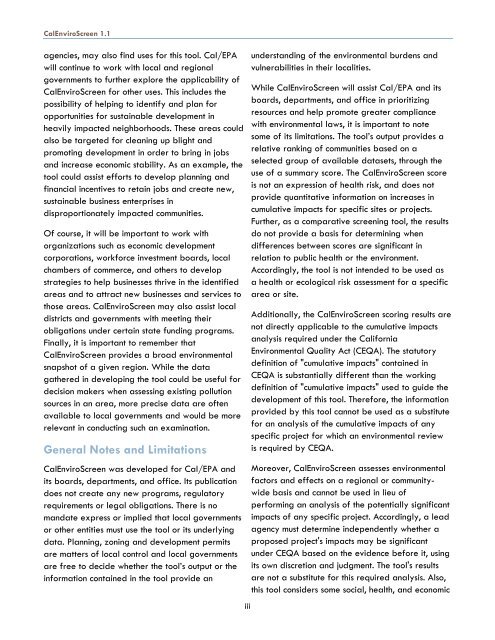CalEnviroscreen Version 1.1 - OEHHA - State of California
CalEnviroscreen Version 1.1 - OEHHA - State of California
CalEnviroscreen Version 1.1 - OEHHA - State of California
Create successful ePaper yourself
Turn your PDF publications into a flip-book with our unique Google optimized e-Paper software.
CalEnviroScreen <strong>1.1</strong><br />
agencies, may also find uses for this tool. Cal/EPA<br />
will continue to work with local and regional<br />
governments to further explore the applicability <strong>of</strong><br />
CalEnviroScreen for other uses. This includes the<br />
possibility <strong>of</strong> helping to identify and plan for<br />
opportunities for sustainable development in<br />
heavily impacted neighborhoods. These areas could<br />
also be targeted for cleaning up blight and<br />
promoting development in order to bring in jobs<br />
and increase economic stability. As an example, the<br />
tool could assist efforts to develop planning and<br />
financial incentives to retain jobs and create new,<br />
sustainable business enterprises in<br />
disproportionately impacted communities.<br />
Of course, it will be important to work with<br />
organizations such as economic development<br />
corporations, workforce investment boards, local<br />
chambers <strong>of</strong> commerce, and others to develop<br />
strategies to help businesses thrive in the identified<br />
areas and to attract new businesses and services to<br />
those areas. CalEnviroScreen may also assist local<br />
districts and governments with meeting their<br />
obligations under certain state funding programs.<br />
Finally, it is important to remember that<br />
CalEnviroScreen provides a broad environmental<br />
snapshot <strong>of</strong> a given region. While the data<br />
gathered in developing the tool could be useful for<br />
decision makers when assessing existing pollution<br />
sources in an area, more precise data are <strong>of</strong>ten<br />
available to local governments and would be more<br />
relevant in conducting such an examination.<br />
General Notes and Limitations<br />
CalEnviroScreen was developed for Cal/EPA and<br />
its boards, departments, and <strong>of</strong>fice. Its publication<br />
does not create any new programs, regulatory<br />
requirements or legal obligations. There is no<br />
mandate express or implied that local governments<br />
or other entities must use the tool or its underlying<br />
data. Planning, zoning and development permits<br />
are matters <strong>of</strong> local control and local governments<br />
are free to decide whether the tool’s output or the<br />
information contained in the tool provide an<br />
iii<br />
understanding <strong>of</strong> the environmental burdens and<br />
vulnerabilities in their localities.<br />
While CalEnviroScreen will assist Cal/EPA and its<br />
boards, departments, and <strong>of</strong>fice in prioritizing<br />
resources and help promote greater compliance<br />
with environmental laws, it is important to note<br />
some <strong>of</strong> its limitations. The tool’s output provides a<br />
relative ranking <strong>of</strong> communities based on a<br />
selected group <strong>of</strong> available datasets, through the<br />
use <strong>of</strong> a summary score. The CalEnviroScreen score<br />
is not an expression <strong>of</strong> health risk, and does not<br />
provide quantitative information on increases in<br />
cumulative impacts for specific sites or projects.<br />
Further, as a comparative screening tool, the results<br />
do not provide a basis for determining when<br />
differences between scores are significant in<br />
relation to public health or the environment.<br />
Accordingly, the tool is not intended to be used as<br />
a health or ecological risk assessment for a specific<br />
area or site.<br />
Additionally, the CalEnviroScreen scoring results are<br />
not directly applicable to the cumulative impacts<br />
analysis required under the <strong>California</strong><br />
Environmental Quality Act (CEQA). The statutory<br />
definition <strong>of</strong> "cumulative impacts" contained in<br />
CEQA is substantially different than the working<br />
definition <strong>of</strong> "cumulative impacts" used to guide the<br />
development <strong>of</strong> this tool. Therefore, the information<br />
provided by this tool cannot be used as a substitute<br />
for an analysis <strong>of</strong> the cumulative impacts <strong>of</strong> any<br />
specific project for which an environmental review<br />
is required by CEQA.<br />
Moreover, CalEnviroScreen assesses environmental<br />
factors and effects on a regional or communitywide<br />
basis and cannot be used in lieu <strong>of</strong><br />
performing an analysis <strong>of</strong> the potentially significant<br />
impacts <strong>of</strong> any specific project. Accordingly, a lead<br />
agency must determine independently whether a<br />
proposed project's impacts may be significant<br />
under CEQA based on the evidence before it, using<br />
its own discretion and judgment. The tool's results<br />
are not a substitute for this required analysis. Also,<br />
this tool considers some social, health, and economic















